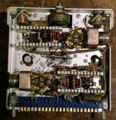661: Difference between revisions
No edit summary |
(added trace picture, corrected typos) |
||
| Line 3: | Line 3: | ||
The mainframe of the 661 is quite simple. It contains a | The mainframe of the 661 is quite simple. It contains a | ||
calibration signal generator and a high-speed pulse generator, but | calibration signal generator and a high-speed pulse generator, but | ||
otherwise is basically just a low-speed X-Y indicator. The total CRT accelerating voltage is just 3kV and the vertical and horizontal amplifiers are relatively mild differential amplifiers made of 6DJ8 tubes. The sophistication of the 661 is all in the plug-ins. The signal from the calibration generator is available on the front panel and is also sent to the timing generator through the multi-pin plug-in connector. This allows the timing plug-ins to select "CAL" as a trigger source. In this mode, the calibration generator can be used as | otherwise is basically just a low-speed X-Y indicator. The total CRT accelerating voltage is just 3kV and the vertical and horizontal amplifiers are relatively mild differential amplifiers made of 6DJ8 tubes. The sophistication of the 661 is all in the plug-ins. The signal from the calibration generator is available on the front panel and is also sent to the timing generator through the multi-pin plug-in connector. This allows the timing plug-ins to select "CAL" as a trigger source. In this mode, the calibration generator can be used as the simulation for the device under test. In many situations, this eliminates the need for external triggering. When the timing unit triggers, a pulse is sent to the high-speed delayed pulse generator in the 661, which triggers and outputs a positive 250mV pulse about 400 nanoseconds long. The rising edge of this pulse is very fast. | ||
The 4S1 is a dual-trace sampling unit for the 661. Each channel has a trigger pickoff, a delay line, and a sampler. The sampling pulses for each channel is generated by a step recovery | The 4S1 is a dual-trace sampling unit for the 661. Each channel has a trigger pickoff, a delay line, and a sampler. The sampling pulses for each channel is generated by a step recovery diode are is fed to a sampling bridge made with of GaAs diodes. These diodes are fragile and exact replacements are hard to find. People have improvised replacements using modern integrated Schottky diodes such as those in HP's HSMS-28x series. | ||
<gallery> | <gallery> | ||
Image:661_top_int.jpg|top internal view | Image:661_top_int.jpg|top internal view | ||
Image:661_front.jpg|front view | Image:661_front.jpg|front view | ||
Image:661_trace.jpg|trace with 10 samples/cm and 2x horizontal expansion | |||
Image:661_left_int.jpg|left internal view | Image:661_left_int.jpg|left internal view | ||
Image:661_rt_int.jpg|right internal view | Image:661_rt_int.jpg|right internal view | ||
Image:4s1_top.jpg|top view of 4S1 | Image:4s1_top.jpg|top view of 4S1 | ||
Revision as of 10:15, 13 December 2008
The Type 661 is a sampling scope made by Tektronix in the 1960's. It accepts two plug-ins: a sampling unit and a timing unit. At least two sampling units were made, the 4S1 (1GHz) and the 4S2 (3.9GHz). At least two timing units were made, the 5T1 and the 5T3. The timing units use tunnel diode triggering. Two coaxial cables in the scope connect the sampling and timing units. One cable sends the trigger pickoff signal from the sampling unit to the timing unit. The other cable sends the timing signal from the timing unit to the sampling unit, telling it when to sample.
The mainframe of the 661 is quite simple. It contains a calibration signal generator and a high-speed pulse generator, but otherwise is basically just a low-speed X-Y indicator. The total CRT accelerating voltage is just 3kV and the vertical and horizontal amplifiers are relatively mild differential amplifiers made of 6DJ8 tubes. The sophistication of the 661 is all in the plug-ins. The signal from the calibration generator is available on the front panel and is also sent to the timing generator through the multi-pin plug-in connector. This allows the timing plug-ins to select "CAL" as a trigger source. In this mode, the calibration generator can be used as the simulation for the device under test. In many situations, this eliminates the need for external triggering. When the timing unit triggers, a pulse is sent to the high-speed delayed pulse generator in the 661, which triggers and outputs a positive 250mV pulse about 400 nanoseconds long. The rising edge of this pulse is very fast.
The 4S1 is a dual-trace sampling unit for the 661. Each channel has a trigger pickoff, a delay line, and a sampler. The sampling pulses for each channel is generated by a step recovery diode are is fed to a sampling bridge made with of GaAs diodes. These diodes are fragile and exact replacements are hard to find. People have improvised replacements using modern integrated Schottky diodes such as those in HP's HSMS-28x series.
-
top internal view
-
front view
-
trace with 10 samples/cm and 2x horizontal expansion
-
left internal view
-
right internal view
-
top view of 4S1
-
Coaxial interconnect from timing plug-in goes through the mainframe, into the 4S1, and ends here, at the sampler.
-
This is the sampler. The GaAs sampling diodes are arranged in a diamond shape and are directly connected to the socket from the delay line.
-
The delay line is a coil of coax going from the trigger pickoff to the sampler.
-
The 661 mainframe has two pieces of 50-ohm coax that connect the sampling unit bay to the timing unit bay. The plug-ins engage with these interconnects when inserted.









